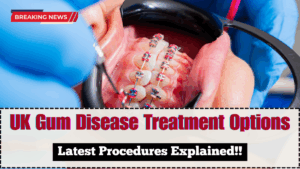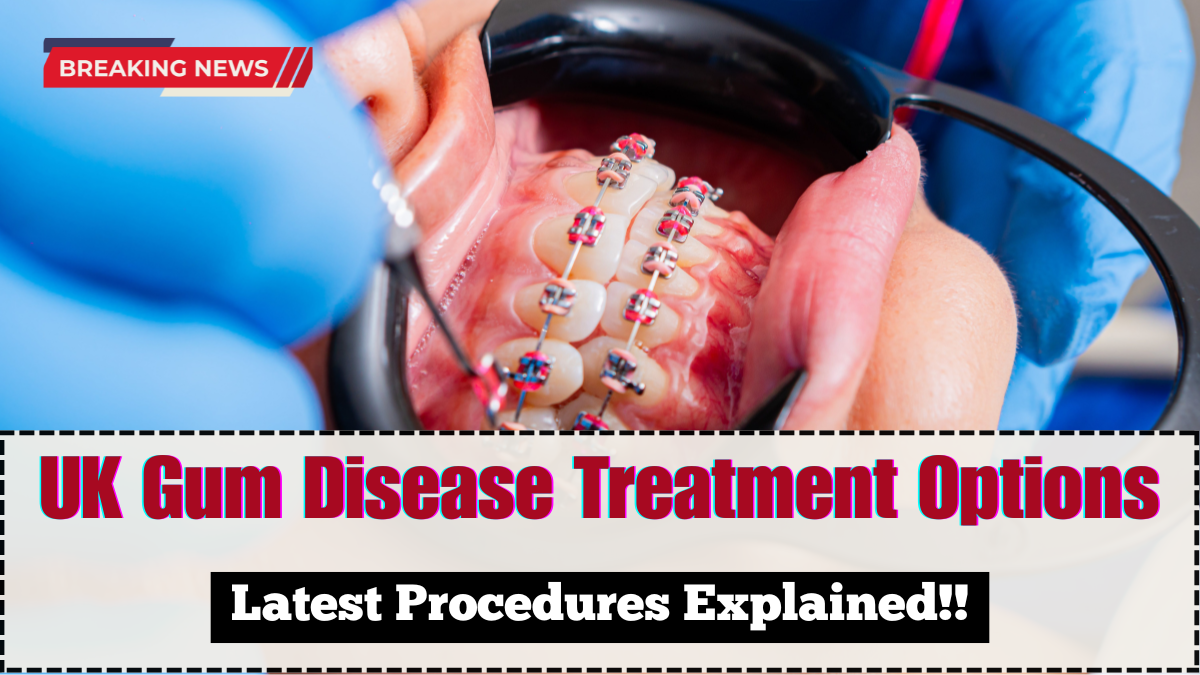Gum disease, medically known as periodontal disease, continues to affect a significant number of adults across the UK. Fortunately, the UK Gum Disease Treatment Options 2025 have seen major improvements, offering patients more effective, faster, and less painful ways to treat early and advanced stages of the condition.
Gum disease is not just a cosmetic issue. Left untreated, it can lead to serious complications, including tooth loss, infections, and even heart health concerns. In 2025, both NHS and private dental clinics across the UK are using enhanced diagnostic tools and modern treatments to combat the rising cases of gum disease 2025.
Let’s explore the most current treatment methods, their benefits, costs, and what patients can expect in terms of recovery and results.

Understanding the Rise in Gum Disease in 2025
In 2025, dental reports indicate a rise in mild to moderate periodontal cases among young adults and the elderly alike. Contributing factors include poor oral hygiene, stress, smoking, and even COVID-era disruptions in dental check-ups. The good news? Early detection and timely intervention make the condition highly treatable.
Dentists across the UK are urging patients to visit regularly and watch for early warning signs, such as:
-
Bleeding gums while brushing
-
Bad breath (halitosis)
-
Swollen or red gums
-
Receding gum lines
-
Loose teeth or changes in bite
Modern UK dental clinics now use advanced scanning tools to detect gum pockets and bone density, allowing for early intervention.
Latest Gum Disease Treatments Available in the UK
The UK Gum Disease Treatment Options 2025 include both non-surgical and surgical procedures, depending on the severity of the condition. Here’s a breakdown of common treatments:
Non-Surgical Treatments
-
Scaling and Root Planing (Deep Cleaning):
Removes plaque and tartar below the gum line. Often the first step in early-stage gum disease treatment. -
Antibiotic Therapy:
Dentists may place antibiotics directly into gum pockets to eliminate bacterial infections. -
Laser Therapy:
A modern, less invasive treatment that uses lasers to remove infected tissue and promote healing.
Surgical Treatments
-
Flap Surgery (Pocket Reduction):
Lifts the gums for deep cleaning around roots and bone, then sutures them back in place. -
Bone Grafts:
Used when gum disease has eroded the bone supporting teeth. A graft stimulates natural regrowth. -
Soft Tissue Grafts:
Replaces receding gum tissue with grafts from the roof of the mouth or donor material. -
Guided Tissue Regeneration:
A technique that encourages bone regrowth by placing a barrier between the bone and gum tissue.
These periodontal treatments have improved in both effectiveness and comfort over the years, making recovery faster and less painful.
Cost and Availability of Gum Treatments in 2025
Whether you’re visiting an NHS dental clinic or a private practice, the cost of treatment varies based on the severity of the gum disease and the treatment method.
| Treatment | Estimated Cost (Private) | NHS Band |
|---|---|---|
| Scaling and Root Planing | £100 – £300 | Band 2 |
| Antibiotic Treatment | £50 – £150 | Band 2 |
| Laser Gum Treatment | £300 – £700 | Not covered |
| Flap Surgery | £600 – £1,200 | Band 3 |
| Bone or Tissue Grafting | £1,000 – £2,500 | Not covered |
-
NHS Coverage: Basic treatments like scaling and flap surgery are covered under Band 2 and Band 3 categories.
-
Private Clinics: Offer more advanced options like laser therapy and grafts, usually not covered by NHS.
Patients are advised to check if their dentist provides treatment through the NHS or if they need a private referral.
Prevention Is Still the Best Cure
In 2025, UK dentists strongly advocate prevention as the most effective weapon against gum disease 2025. Patients are encouraged to:
-
Brush twice a day with fluoride toothpaste
-
Floss or use interdental brushes daily
-
Visit the dentist every 6 months for cleanings
-
Avoid smoking and manage stress
-
Maintain a balanced, low-sugar diet
New oral hygiene tools such as electric toothbrushes with AI tracking and antibacterial mouthwashes are helping UK residents stay ahead of periodontal disease.
FAQs
What is the most common treatment for gum disease in the UK in 2025?
The most common treatments include scaling and root planing (deep cleaning), often followed by antibiotic therapy for mild to moderate cases.
Is laser gum treatment available on the NHS?
No, laser therapy is typically available only through private clinics in the UK.
How can I tell if I have gum disease?
Bleeding gums, bad breath, and gum sensitivity are early signs. Regular dental check-ups are key to early detection.
Can gum disease be completely cured?
In early stages, yes. With proper care and treatment, gum disease can be reversed or halted. Advanced cases may require ongoing management.
What happens if gum disease is left untreated?
It can lead to tooth loss, bone damage, and may even contribute to systemic conditions like heart disease and diabetes.
Click here to know more.
